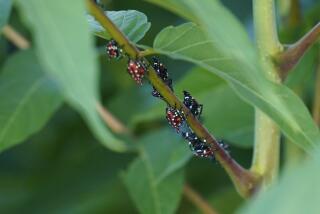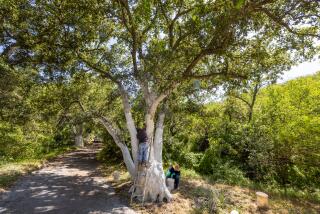Insect Infestations Threaten Hemlocks
- Share via
BALD EAGLE STATE FOREST, Pa. — At first glance, the forest around Sand Spring Run looks just as it should, with a lush understory of grasses and ferns shaded by tall maple, oak and hemlock.
But a closer look shows that the hemlock trees -- a keystone species along streams like this -- are under attack from at least two insects with the potential to devastate hemlock stands throughout the Northeast.
Usually dark green, the hemlock’s needles have faded to a pale, almost yellow color indicative of an infestation of elongate hemlock scale insects.
The cottony, white spots indicate the tree also is infested with hemlock woolly adelgid.
Together, these insects are teaming up on hemlocks from Virginia to southern New England and west to Ohio.
“When you combine elongate hemlock scale and hemlock woolly adelgid, that really is a one-two punch,” said Richard Cowles, associate entomologist at the Connecticut Agricultural Experiment Station.
And their bite has gotten worse in recent years, when much of the Northeast suffered under drought conditions. Both insects survive by piercing hemlock needles and sucking them dry -- the adelgid feeds directly on the tree’s vascular system, while the elongate scale (there are multiple hemlock scale species) drains fluid from the tree’s cells.
“The drought stress of previous years, in combination with these insects that have piercing, sucking mouth parts, have really exacerbated the whole effect and have led to an even more quick decline of hemlock in the forest, as well as in the landscape,” said Greg Hoover, a Penn State University Extension entomologist.
Although it once served as a source of tannic acid for tanning leather and hides, the tree now is valued more for its aesthetic and environmental value.
“Our 167 state parks, virtually all of them were placed in hemlock stands, because of the streams and the cool shade, the idyllic forest setting,” said Mike Blumenthal, forest health supervisor for the Pennsylvania Bureau of Forestry. “It would have a tremendous impact on recreation if we were to lose hemlocks.
“Hemlocks also are extremely important in stabilizing the soil around streams, in filtering the water that goes into those headwater streams. They’re very, very important in preserving water quality,” Blumenthal said.
Scientists have developed several methods of fighting the woolly adelgid, including both topical and systemic insecticides and finding beetle species that will eat the adelgid.
But elongate hemlock scale has proven to be more of a problem.
Because hemlocks grow in environmentally sensitive areas, spraying topical pesticides is impractical, Hoover said. Even where they can be sprayed, the insect coats itself in a waxy, protective substance.
Systemic insecticides don’t seem to work either, Hoover said, and can even ward off or poison species that might prey on the elongate hemlock scale.
But researchers in New Jersey have identified a beetle, Cybocephalus nipponicus, that might be used in fighting elongate hemlock scale. Pennsylvania officials have released 2,000 of the beetles in a scale-infected forest in Lycoming County, and hope to have more by the end of the summer.
“Fairly recently, and quite by accident, the New Jersey Department of Agriculture was rearing an exotic predatory beetle from Korea that eats the scale pest of a horticultural shrubbery,” Blumenthal said. “They quite accidentally found that this beetle moved over from infected Euonymus scale to elongate hemlock scale.”
Cowles said there’s also hope in a fungus found in southwestern Connecticut and eastern New York that seems to be infecting the insect without affecting other species.
Scientists are trying to identify the fungus and determine whether it can be used against elongate hemlock scale elsewhere.
“This fungus, at this point, does not seem to be one that can be grown on petri dishes. ... It has to be in the host, so we haven’t even been able to identify what the fungus is,” Cowles said.
More to Read
Sign up for Essential California
The most important California stories and recommendations in your inbox every morning.
You may occasionally receive promotional content from the Los Angeles Times.













